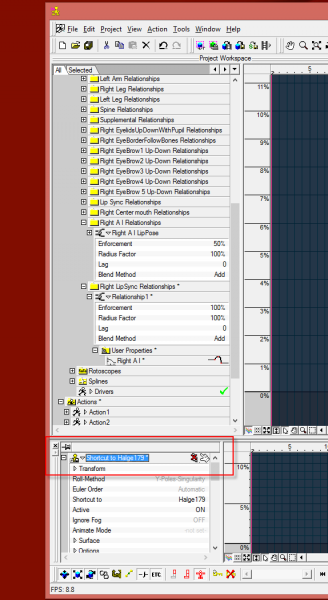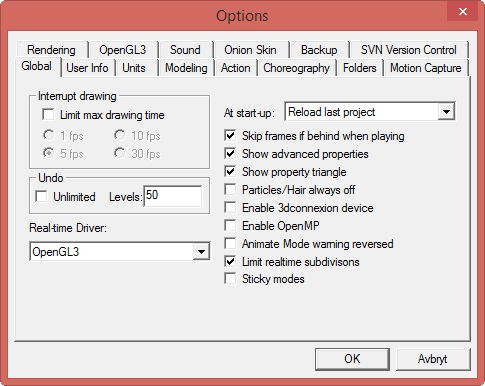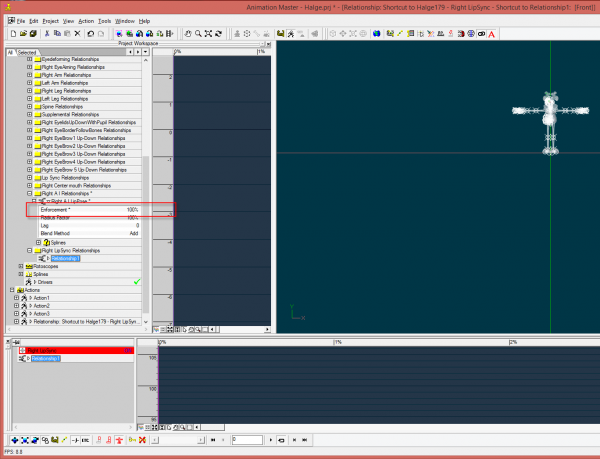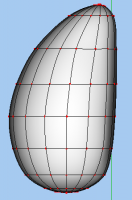-
Posts
46 -
Joined
-
Last visited
Content Type
Profiles
Forums
Events
Everything posted by Visping
-
I think I will try my way forward and see what the result looks like. In any case the control of the pose will be useful for me. And as a bonus I now understand how to key properties. It is great to take part of the way more experienced animators reason. Thanks for sharing, Rodney and Robert! And thanks for the tip! I have ordered "Stop staring" now
- 17 replies
-
- Enforcement
- pose
-
(and 1 more)
Tagged with:
-
It´s good to know that I wasn´t so far out after all, Rodney You´ve got me curious to explore the possibilities of driving other poses than lip sync by dopesheets, but that will be a later matter!
- 17 replies
-
- Enforcement
- pose
-
(and 1 more)
Tagged with:
-
Rodney, I am under the impression that the strength in using dopesheet during lip sync is speeding up the pipeline. After the dopesheet has done its work I will have to fine tune the lip sync anyway. Would you agree? Or do you think using dopesheet doesn´t bring any advantages?
- 17 replies
-
- Enforcement
- pose
-
(and 1 more)
Tagged with:
-
Thank you Robert! You picked up exactly what I wanted to do and demonstrated it so even I understood perfectly I have just one question. You mentioned in the end of the explanation that this is probably not the way you would do it. Could you give me the reason for that? It would be good to know if I am heading in the wrong direction not realizing that there is a more obvious solution.
- 17 replies
-
- Enforcement
- pose
-
(and 1 more)
Tagged with:
-
Great! I am looking forward to it
- 17 replies
-
- Enforcement
- pose
-
(and 1 more)
Tagged with:
-
When opening the Action node I can see that when working with a relationship a temporary action is shown. In it there is a shortcut to the whole model who has this little icon. Is this the one?
- 17 replies
-
- Enforcement
- pose
-
(and 1 more)
Tagged with:
-
I have searched in AM but can't find "Show more than drivers". My first guess would be in options, but I can't find it... Where can i find it?
- 17 replies
-
- Enforcement
- pose
-
(and 1 more)
Tagged with:
-
- 17 replies
-
- Enforcement
- pose
-
(and 1 more)
Tagged with:
-
I would like to be able to control the Enforcement of a percentage Pose from a on/off Pose. Is it even possible? I am constructing a character who is talking trough the corner of his mouth. Witch corner he is talking trough is varying depending on angle to the camera. I am planning to use Dope Sheet to quickly make the basic lip sync before fine tuning it. I am going for this approach: I make two percentage poses for all phonemes, one for each side (Right A I, Left A I, Right E, Left E, Right O, Left O etc.) and form the expressions of the mouth. Then I make a percentage Pose for each phoneme (A I, E, O etc.) In these poses I control the poses above (Pose A I at 100% vill set both Pose Right A I and Pose Left A I to 100 %) And finally I make an on/off Pose for each side of the mouth (Right LipSync and Left LipSync) This is where I want to control the enforcement of the right and left poses.... The result would be: When Right LipSync is on and Left LipSync is off my character will speak only from the right corner of the mouth. When Left LipSync is on and Right LipSync is off my character will speak only from the left corner of the mouth. And if both poses are on he will speak from both corners of the mouth. By this approach I am aiming for a dynamic way of changing "talking sides" while having the dope sheet to speed up the lip sync. I tried to do this but the Enforcement did not stick when trying to set it in the relationship... Is this kind of control not supported in Animation Master? If not, do anyone have any suggestions for a workaround to achieve what I aim for?
- 17 replies
-
- Enforcement
- pose
-
(and 1 more)
Tagged with:
-
Thank you Rodney for your reply. I am familiar with the Preston Blair phoneme set, so that is not the problem. The problem is that I can not find any similar way of transcribing the pronunciation of words when I search the Internet..... Animation Masters dictionary presents the words in a list. After each list is a transcribed version of each word of how it is pronounced. I could not find any other dic-files on the Internet having phonetic transcription after the words at all. To be able to make my own dictionary I need to understand how to write phonetic transcription from scratch. As you can see from the example below words seemingly sounding alike (first part of the words) has different phonetic transcription. That is why a guide or some sort of documentation would help me very much... phoneme 'f/oU/n/i/m phonemicist f/oU/'n/i/m/I/s/I/st phonemicize f/oU/'n/i/m/I/,s/aI/z phonemics f/@/'n/i/m/I/ks
- 5 replies
-
- Dope sheet
- phonemic
-
(and 2 more)
Tagged with:
-
I would like to use dope sheets when animating my character. But as my native language is not english I would like to make my own dictionary in swedish. I think I can just replace the dictionary.dic with a swedish dictionary. But there is a problem: I do not recognize the way the phonemes are written. What phonemic alphabet is used in Animation Master? I can tell it is not the IPA by International Phonetic Association. Does anybody know of any documentation that explains the way phonemes are to be written in the Dictionary.dic to work properly in Animation Masters dope sheet? phoneme 'f/oU/n/i/m phonemicist f/oU/'n/i/m/I/s/I/st phonemicize f/oU/'n/i/m/I/,s/aI/z phonemics f/@/'n/i/m/I/ks
- 5 replies
-
- Dope sheet
- phonemic
-
(and 2 more)
Tagged with:
-
I have started installing the rig in my character and it seems easy to use. And that was what I was looking for. How would you suggest using the Saucy-rig on a character with only four fingers? Should I just hide the bones I do not use for my nonexisting finger? Or should I delete them? Which finger-bones are recommended to keep and which finger-bones are recommended to skip? If I delete them maybe there will be some future problems with the behaviour of the rig? Maybe there is a standard way of doing this?
-
Thank you Furchur! I will continue with the CP weights for the fingers. Good to know I am not way of tracks. /Stefan
-
I am rigging the fingers of a hand and I know of 3 different ways to make the CPs move in a controlled fashion: Smart skin Fan bones CP weights I have found tutorials for each of them but I have not found the overall explanation how to think when choosing between them. In my case of the fingers, I started weighing the CPs and planned to do some smartskinning in the next step to tweak it more precisely.... But in the middle of the work I asked myself; Is this a good approach? I am worried that if I combine smartskin and CP weighing it will be confusing, for me, if I afterwards need to correct some unwanted behaviors of the fingers. What is the best practice? Is it to keep it clean and only stick to one or does it not matter if I combine them?
-
I would never have guessed the tecnique used before I watched the Making of. Amazing!
-
Thank you Mark and Robert, I suggest just a small adjustment in the second description, as the problem seems to be in real-time according to both my findings and Roberts latest post: 2: If the Aiming bone in a Surface Constraint has an additional Aim At constraint applied to it, so that it follows/is controlled by a target null. The bone that was constrained to the surface in this Surface Constraint setup stops moving in real-time. The flickering in the video was exatly what I experienced. Thank you guys! I wish I had posted my problems earlier. I wasted a lot of hours (days) trying to understand what I was doing wrong. This forum is really great.
-
I see, it looks like I have been chasing the wrong problem. Would you say that these things qualify as bugs in Animation Master or is my use of those constraints simply a way they are not intended for? At this point I have started working on the "oval eye" tecnique and after finishing that I will evaluate what works best for me. At least now I have the workaround, you suggested Mark, as an option, Thank you!
-
I was also thinking that but I am too inexperienced to be sure. The most probably reason for my problems would be my lack of knowledge.. I am very glad you are looking into this! Yes and no. I got the pupil to move in Choreography. But sometimes the pupil left the Surface for quite a distance. I did not experience any connection to even or odd frame as you did. Due to my lack of experience working in the Chor it was a little confusing though. Sometimes it followed the aiming bone and sometimes it did not. After a while I identified that when playing animated/recorded frames it worked. But when manually moving the targetbone (that the aimingbone is aimed at) it gave no effect. But if I played the animated movement of the targetbone then the pupil moved... I expected the surface constraint to work directly just like the Aim at constraint does. I also noticed a difference between your video tutorial and my test: You allways seem to automatically get Compensate mode button set to ON. While this button has never ever automatically been set to ON. I dont know if this is relevant to this case... Yes I read a topic about that on the forum and it seemed a bit tricky.
-
I have studied both Keekat and Rabbit in my hunt for the solution for my problems with the Surface constraint. Keekat and Rabbit do not use surface constraints. In both cases they use the same aproach as in the EyeTutorial on the Extras DVD; the Eye is a sphere and the pupil is moved sperically by a bone that is a Child of the eyebone. When translating the Eyebone the pupilbone and the meshes for the Eye and the pupil are deformed, as a whole, to an oval. As the translation takes Place in an On/Off pose that is set to ON, the eyes automatically Changes shape when opened in an Action or Chor. This works great for most comic characters but in my case I wanted to follow my characters layout which has irregular Eyes that are not just oval. At this Point I feel defeated and I think I must abandon the idea of surface constraints all together just to be able to move forward. I will try to compromise and use an Oval Eye as described in the Eye tutorial. Thanks a lot guys for trying to help out
-
I have deleted the constraints over and over again and put them in an On/Off pose. You experienced exactly the same situation as I did. The pupil do not move as intended. At least now I know that I am not the only one having trouble making this work. Thanks for trying markw Yes it is intentional to have the pupil as a boolean cutter. The pupil is a hole in the iris letting the light into the eye. I wanted to try the aproach with a hole in the eyewhite instead of having a pupil sliding on top of the surface
-
If this is so I seem to have been trying to obtain something that is doomed from beginning. But the Technical reference for Animation Master (page 181) gives this example for use "...or slide pupils along the surface of an irregularly shaped eyeball." Is it self-evident that this can only be done in an action or choreography? The Technical Reference says nothing about the fact that this constraint only can be used in an action or in a choreography.... It just says that in choreography an entire model may be chosen as the target surface and that implys that this constraint is used like all the other constraints plus can be used in chor to use a whole model. Are you sure it can not be done inside a model Gerry, or is it a theory at this point? Should I abandon my aproach all together? Is it a really bad idea to use surface constraints? Please give me some advice! I am a beginner so all the self-evident stuff is not clear to me yet
-
Thank you for the tip! Yes I have the Extra DVD and have seen that tutorial but it does not work all the way for me as my Eye has not exactly an oval form. My Eye has a wide base and a narrow top and I dont think scaling the bone can accomplish that.
-
Thanks Robert, I am very grateful for all your efforts to explain . A very good tutorial! But I dont think I have got it backwards. The difference, as I understand it, between your demo and my constraintsproblem is that I am trying to do this in the model and you are making a constraint between two models in a choreography... I think it could be applied in both situations or is it not allowed to use Surface constraints inside a model? I have attached the part of my model with the constraints problems. ConstraintsProblem.mdl I think all properties are set by the book, but it just doesnt happen... The bone I want to constrain and follow the Surface: Right PupilBone Surface Target: Right EyeSurface Surface Aim Target: Right PupilAimingBone To clearly see the relevant meshes you can select the Groups Right EyeWhite+Right EyePupil and hide the rest. Maybe I have got it all wrong after all...?? For background information: I am trying to make the pupil following the irregular Eye as a boolean cutter. Outside the Eye White and the pupil I have transparant reflective Surface. If I finaly will get the pupil surface constraint to work, the next step is making an eyelid follow the transparent eye surface using the same surface constraint tecnique. (With a separate bone and aiming bone for each spline crossing)
-
I am having problems getting the Surface constraint working. I think I have done it by the book, but the bone that is supposed to move in line with the aiming bone does not move at all. I have set the aiming bone to aim at a target but when moving the target, the aiming bone follows allright but the bone is not following. (If I test by changing the enforcement on the Surface constraint it moves. But when moving the target it does not). If I make the bone a Child of the aiming bone it moves but it "hops around" sometimes and does not follow the surface smoothly all the time. (But the bone should not have to be a Child to follow the aiming bone, should it?) I have tested all the propertys I could find with no result. I had help on this forum before but those advices does not help me now. I have spent a week trying to figure it out. This should be straight forward but it is driving me crazy . Could anybody explain what I am doing wrong?
-
Yes I am familiar with those. Now I understand how to do it. Thank you





